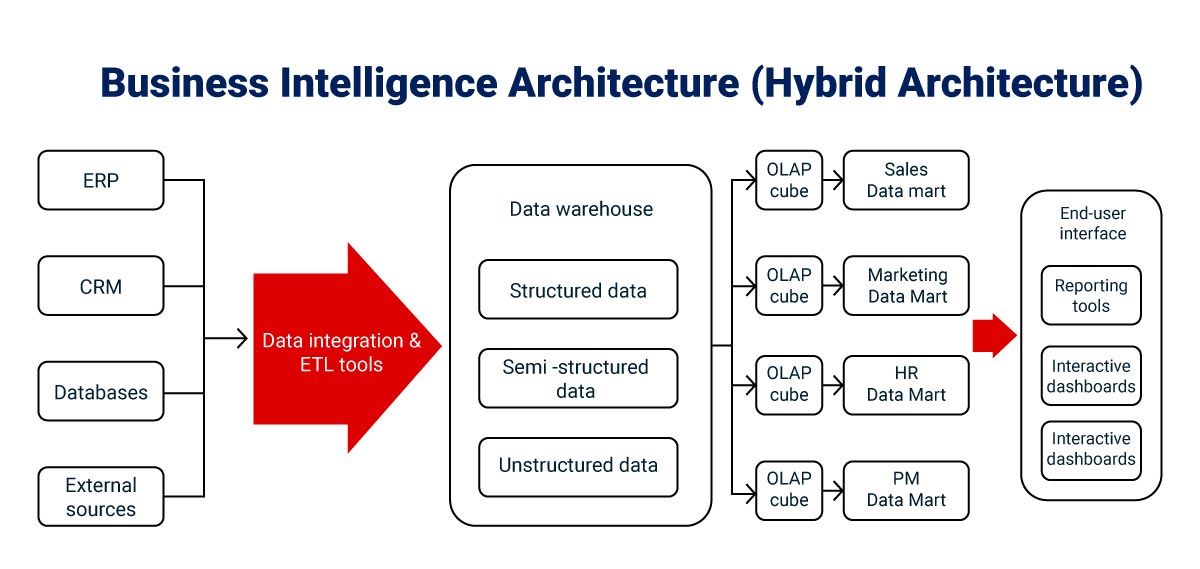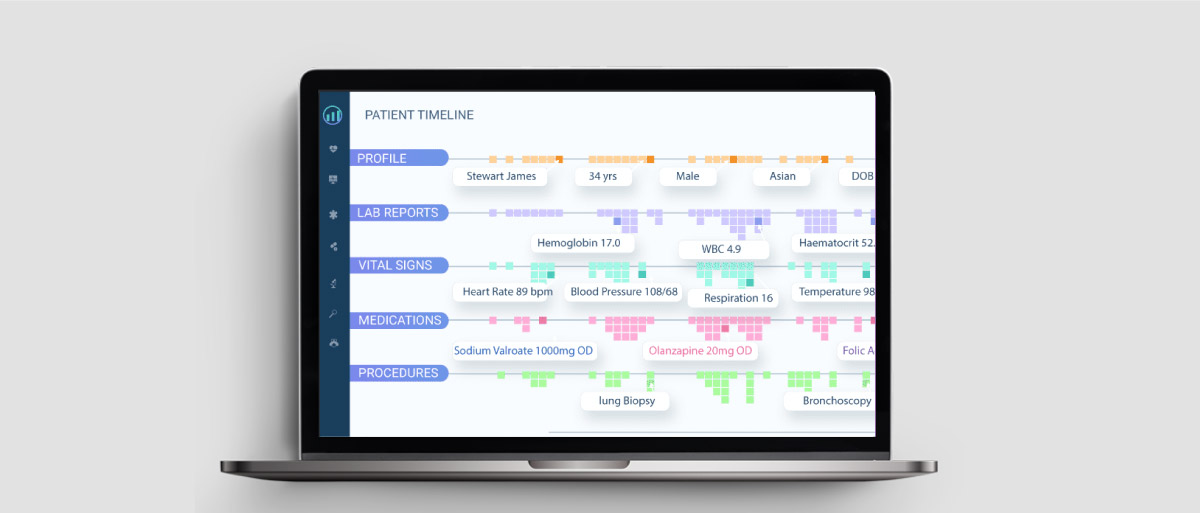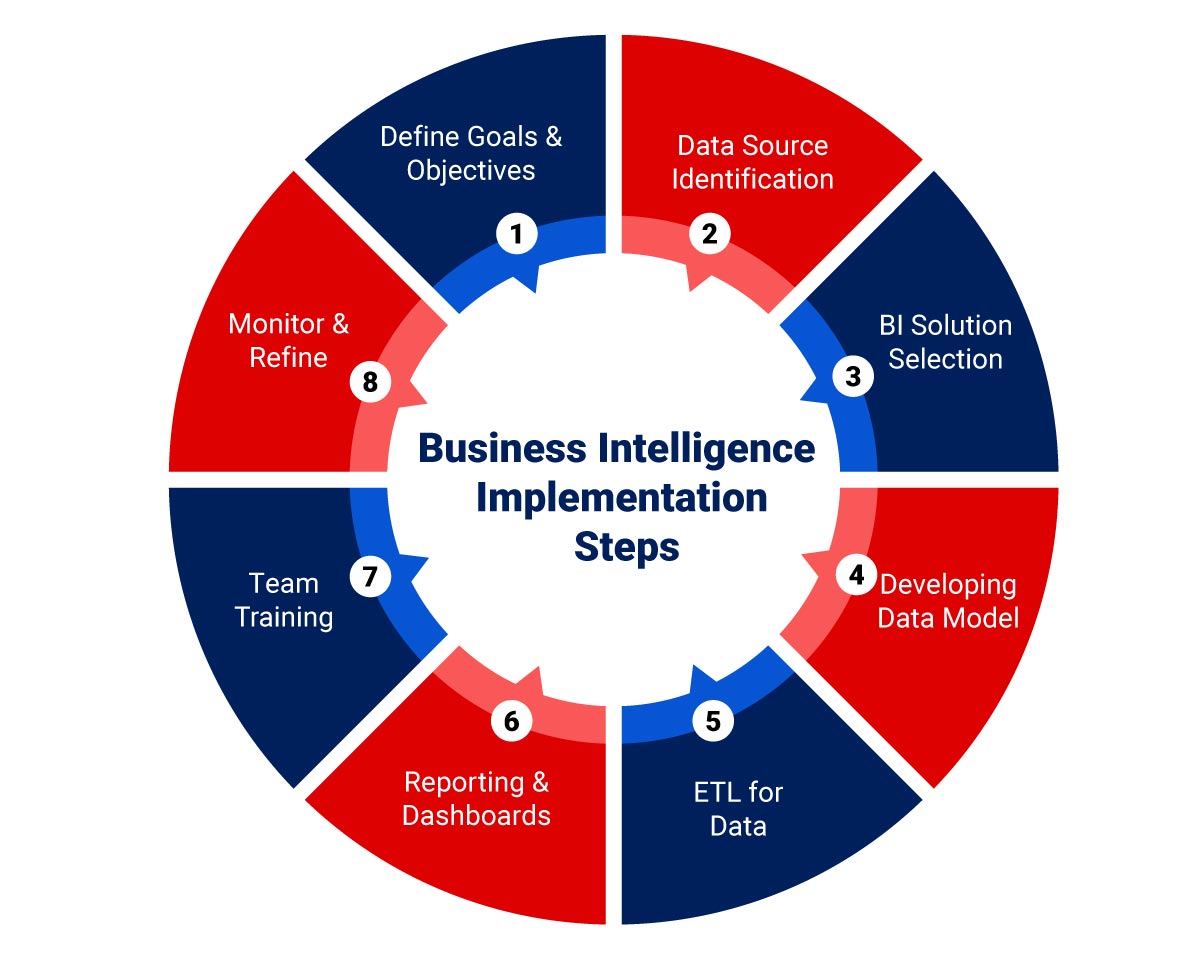From everyday decision-making to optimizing the use of resources to predicting future needs, Enterprise Business Intelligence plays a vital role in how a business operates and eventually grows. Back in the day, business decisions were often based on prior experience, accumulated knowledge, or intuition. But dedicated business intelligence (BI) tools are replacing it with data-driven decision-making. They combine data analysis, visualization & reporting capabilities to uncover actionable information. Further, it can be delivered to executives, managers & other business users.
Enterprise business intelligence enables monitoring business operations and optimizing the usage of available resources. This comprehensive blog will provide practical insights into challenges it can solve, core features, capabilities, common BI use cases, and more. So, let’s get started!
What is Enterprise Business Intelligence (EBI)?
It refers to using technologies, tools, and techniques to collect, analyze, and present data from various sources within an organization. EBI aims to provide decision-makers with insights into their company’s operations, trends, and opportunities, enabling them to make informed business decisions. It typically includes data warehousing, data mining, online analytical processing (OLAP), and other data analysis tools to extract meaningful insights from large and complex datasets. The data is typically gathered from various internal and external sources, including transactional systems, customer relationship management (CRM) systems, and social media platforms.
It unifies multi-formatted data from your company’s departments into a centralized repository to enable data-driven decision-making with role-based access to the analytics results.
An enterprise business intelligence (BI) solution can provide numerous benefits to your business, including:
- Improved Decision-making: BI solutions provide robust data analysis capabilities that enable businesses to make informed decisions. By collecting and analyzing data from various sources, an enterprise BI solution can help you identify patterns, trends, and insights that can inform business decisions and help you make logical choices.
- Increased Efficiency: An enterprise BI solution can automate many manual data-related tasks, reducing the time and resources required. It allows employees to focus on higher-value tasks that require more specialized skills, improving overall efficiency.
- Better Data Quality: An enterprise BI solution can help ensure data is accurate and consistent across different systems and departments. It can reduce errors and improve data quality, leading to better decision-making and more efficient operations.
- Increased Transparency: BI solutions provide visibility into key performance metrics and business processes, allowing managers and employees to track progress and identify areas for improvement. This can improve transparency and accountability throughout the organization.
- Competitive Advantage: An enterprise BI solution can give businesses a competitive edge by providing better insights and faster decision-making. It can help companies stay ahead of the curve and adapt quickly to changing market conditions.
An enterprise BI solution can help businesses become more data-driven, efficient, and competitive, ultimately leading to better business outcomes.
Challenges an enterprise BI solution can solve,
- Unifying different formats and structures of data lying in siloed systems using other data models
- Addressing the issues with data quality resulting from manual data processing and management methods
- Inconsistencies in recording data across departments
- Inability to secure confidential and sensitive information
- Varied needs and demands for analytics and customized reporting
- Data aggregating challenges arising due to various federal, provincial, and territorial regulations applicable to different counties & regions
- Varying degrees of data maturity across business divisions & functions
Enterprise Business Intelligence Architecture Components

The underlying architecture plays a crucial role in the successful implementation of an enterprise BI solution that uses data analysis to help your company:
- Track business performance
- Optimize operations
- Identify new business opportunities
- Improvise strategic planning
- Drive informed decisions
A robust business intelligence architecture lays the foundation for data management and technology standards with best analytics practices. It serves as a blueprint for consolidating, organizing, processing, managing, and making data available for visualization and reporting. Let’s look at what goes into putting such a framework;
Data Integration
A temporary staging area is needed to ensure data quality and integrity while extracting, transforming, and loading data from disparate sources. It enables:
- Data deduplication
- Data pre-aggregation
- Standardization of information across multiple sources
- Identification and elimination of invalid data from different sources
Storage
This layer needs subsets specific to all associated business lines to facilitate data storage for further analytical processing and reporting. It includes:
- A data lake to store, process and secure unstructured, semi-structured, and structured data in its native format
- Data warehouse for reading massive amounts of data and optimizing it for analysis
- Data marts for secure querying of business data specific to a particular group
- Operational data store to integrate current operative data from different sources
Analytics
- To analyze historical and real-time data using OLAP tools
- To create predictive models and run what-if scenarios collected over time with machine learning tools
Reporting
- To create diagrams, heat maps, graphs, charts, using visualization tools
- To run ad hoc queries using self-service business intelligence tools
Visualization
- Pre-designed and custom reports, scorecards, and dashboards to visualize all types of business information
- ML-driven prescriptions, recommendations, push notifications, and alerts
- Intuitive dashboards, interactive portals with search filters, configurable views, and drill-down capabilities with real-time data access.
Key Features of An Enterprise Business Intelligence Solution
An EBI solution is a comprehensive system that integrates various tools, technologies, and practices to collect, analyze, and visualize data from multiple sources to help organizations make informed decisions. The key features of an Enterprise BI solution are:
- Data Integration: Should be capable of integrating data from various sources, including internal and external sources, such as ERP systems, databases, spreadsheets, and cloud applications.
- Data Warehousing: A centralized data repository, such as a data warehouse, must be used to store and manage all the data the organization requires.
- Analytics and Reporting: Must provide analytics and reporting capabilities that allow users to generate custom reports, interactive dashboards, and visualizations to gain insights into data.
- Data Mining and Machine Learning: Must offer advanced analytics capabilities, including data mining and machine learning algorithms, to identify patterns and trends in the data that might not be immediately apparent.
- Collaboration: Should provide features that allow multiple users to work together on data analysis and share insights and reports.
- Mobile Support: Must offer mobile support, allowing users to access the system from any device, including smartphones and tablets.
- Security and Governance: Should have robust security and governance features to ensure that the data is secure and that users can access only the data they are authorized to view.
- Scalability: Must be scalable to accommodate the organization’s growing needs and should support large volumes of data and users.
Capabilities of an Enterprise BI Software
Companies that aim to collate and analyze complex and larger datasets can look for the following capabilities in their chosen BI solution:
Advanced Analytics
- Ask questions and get answers on-the-go
- Extract insights with statistics capabilities
- Get a strategic view of granular data
Collaboration
- Ensure seamless collaboration between users across departments
- Securely store, share, and distribute data with external stakeholders without losing the data in transit
Integration
- Seamlessly integrate disparate heterogeneous on-premise and cloud-based data structures
- Easily access data on any device, desktop, or laptop
- Automate the exploration, cleaning, processing & updating of metadata
Visualization
- Generate mobile and paginated reports for a wide range of KPIs for all types of business users
- Leverage interactive dashboards with drag-and-drop features and dynamic search filters and
- Embed analytics content directly into business apps for optimal use
Governance
- Maximize the consistency, accuracy, and reusability of analysis for robust reporting
- Secure proprietary data with restricted access to unauthorized users
Self-service
- Automate the conversions of currency for approved rules.
- Apply business rules to generate new calculated values from current data
- AI-supported data analysis.
- Automate the detection and labeling of sensitive business data
You must choose an enterprise business intelligence platform with the abovementioned capabilities to use your data efficiently and optimally. However, BI solutions constantly evolve, so pick the one that prioritizes scalability and enables innovation.
Our Enterprise BI Focus: Highlights
We offer a full range of Business Intelligence services to integrate multi-source data and apply analytics techniques to extract insights from the input records automatically. Our team of data management professionals utilizes a comprehensive tech stack that comprises data visualization technologies like – Power BI, SQL reporting service & data warehousing using – MySQL, SQL Server, Hadoop & Talend.
Listed below are the services we offer for Enterprise BI Implementation;
- Business Intelligence Consulting
- Data Warehousing
- Reporting & Data Visualization
- Migration & Modernization
With our Power BI consulting & Power BI development services focus, we support you in defining BI strategy while architecting & implementing the needed infrastructure. Our team supports you with data preparation, identifying the right KPIs, helping develop personalization options with dashboards, integrating third-party solutions & embedding scalable data models.
We offer;
- Power BI Development
- Power BI Data Modeling & Analytics
- Power BI Integration & Customization
- Power BI Visualization & Reporting
- Power BI Migration
Success Story:
Case Study: Machine Learning (ML)-based Healthcare Monitoring System

A UK-based medical services provider sought to enhance the diagnosis & treatment quality for critical care patients. For this, the need was to develop a standalone alone system that collates recorded data (historical & current health data sets) from various connected devices and the patient’s vitals.
We helped develop an ML-based healthcare monitoring system that records & analyzes large data sets of patient health in real-time to enable informed decisions.
Benefits Delivered;
- 5x increase in operational efficiency
- 63% accurate diagnosis through ML models
- Real-time data collection & patient-intelligence
Read more about this Machine Learning Driven Healthcare Monitoring System, its key features, and how it helped improve clinical efficiency and patient care.
Enterprise Applications of Business Intelligence Across Industries
BI is a technology-driven process that analyzes data and presents actionable insights to help businesses make more informed decisions. Today many industries use one or the other BI solution to predict future outcomes, improve employee satisfaction, and gain a competitive edge.
Here are some use cases of enterprise business intelligence solutions applicable across different industries:
- Healthcare: BI applications can help hospitals and clinics manage patient data, improve patient outcomes, and reduce costs. BI tools can help healthcare providers analyze patient data and identify trends and patterns that can inform treatment plans. BI can also help hospitals optimize staffing levels, manage inventory, and track patient flow.
- Financial Services: BI applications are widely used in the financial services industry to analyze financial data, manage risk, and improve customer service. Financial institutions use BI tools to analyze customer data, identify fraud, and manage credit risk. BI can also help financial services companies optimize pricing and streamline operations.
- Logistics & SCM: Transportation companies plan their distribution schedules and optimize routes using the inferences generated from analytics tools. They also use BI to track the vehicle’s location, fuel consumption, idle time, and other aspects of fleet operations.
- Retailers: Sellers can plan their product promotions and marketing campaigns using BI and analytics platforms while leveraging their capabilities to optimize inventory management and order fulfillment.
- Manufacturers: BI software aids manufacturers in monitoring production processes, optimizing supply chain management, and improving quality control. BI tools can help manufacturers track production schedules, manage inventory levels, and identify quality issues. BI can also help manufacturers optimize supply chain logistics, reduce costs, and improve operational efficiency.
- Hospitality: BI applications can help hotels and resorts manage guest data, improve customer service, and optimize pricing strategies. BI tools can help hospitality providers analyze guest data and preferences, identify trends and patterns, and develop targeted marketing campaigns. Further, it can also help hospitality providers optimize room rates, inventory management, and staffing levels.
- Aviation: Airline companies employ to track flight occupancy and ticket sales. The insights enable them to efficiently manage flight schedules, ticket pricing, food and beverage orders, and crew assignments.
Business Intelligence Implementation Steps

Our BI implementation strategy aims to create a centralized approach using your data and analytics to support your decision-making mechanism and drive desired outcomes. It includes the following steps:
- Define Your Goals and Objectives: The first step in implementing BI is to define your business goals and objectives. Identify the information you need to achieve your goals and ensure you have the resources and technology to support your purpose.
- Identify Your Data Sources: Identify the sources you will use to achieve your goals. It may include internal data sources such as databases, spreadsheets, and other files and external data sources such as market research reports and customer surveys.
- Choose a BI Solution: Choose a BI solution (Power BI, Tableau, or others) that fits your business requirements. Many BI solutions are available, and each has its strengths and weaknesses. It would include consideration of factors such as scalability, ease of use, and cost while selecting a solution.
- Develop a Data Model: Develop a data model that maps your data sources to your business objectives. This model will help you organize your data and collect the correct information.
- Extract, Transform, and Load (ETL) Your Data: Use ETL tools to extract data from your data sources, transform it into a format suitable for analysis, and load it into your data warehouse or data lake.
- Develop Reports and Dashboards: Develop reports and dashboards that visualize your data in a way that is easy to understand. These reports and dashboards should be designed to support your business goals and provide insights that help you make informed decisions
- Train Your Team: Train your team to use the BI solution effectively. Ensure that they understand how to use the reports and dashboards and know how to interpret the data to make informed decisions.
- Monitor and Refine: To ensure it achieves your business objectives. Refine your implementation to improve the accuracy and relevance of your reports and dashboards.
Technologies We Use for Building Enterprise BI Solutions
Power BI
Best suited for enterprise-wide business analysis
Key Features:
- Data ingestion with more than 120 connectors for big data sources, relational databases and operational databases
- Secure data access
- Self-service analytics for customized reporting
- Custom visualizations with Python and R
- Power Query to source and transform data
- Seamless integration with Microsoft Products
Tableau
Ideal for data-driven companies that want to collaborate with data using self-service analytics.
Key Features:
- Supports different kinds of data connectors
- Integrated advanced visualizations and informative maps
- Enables easy creation of trend lines
- Supports external service integration
- Role-Based Permissions
Microsoft SQL Server Business Intelligence
Recommended for automated querying and reporting across data sources
Key Features:
- Self-service predictive analytics
- Power Pivot to create data models
- 3D maps to visualize data
- Data mining algorithms
- Query across disparate data sources
Cost Factors to Consider for Implementing an Enterprise BI Solution
The cost of implementing an enterprise business intelligence solution varies considerably depending on different factors such as:
- Data integration and migration costs:
- The number of various data sources, their ability to integrate with other apps and systems, and the current data models
- The size, structure, variety, and volume of existing business data
- The complexities involved in cleansing business data
- The complexity of the data storage layer
- Development and customization costs
- Training costs
- Data security and governance costs
- Deployment and implementation costs
- Maintenance and support costs
- Consulting and professional services costs
- Change management costs
Concluding Thoughts
In conclusion, enterprise business intelligence is critical in helping organizations gain insights into their operations, customers, and market trends. It provides decision-makers with data-driven insights that enable them to make informed decisions, identify opportunities, and mitigate risks. Implementing an effective enterprise business intelligence system requires careful planning, robust data management, and the integration of cutting-edge technologies. By investing in enterprise business intelligence, organizations can gain a competitive edge in their industries and position themselves for long-term success.











 30 Min
30 Min


